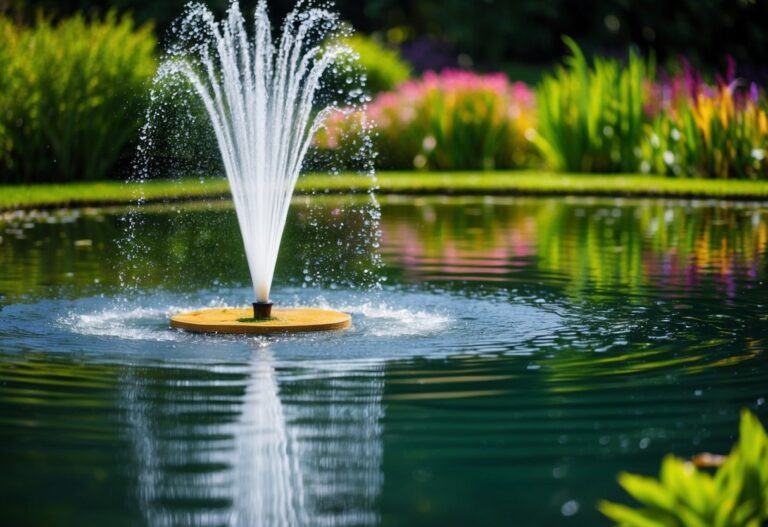Pond aeration and oxygenation are essential processes for maintaining a healthy aquatic environment.
Oxygen levels influence every living organism within the water, from fish to plants to beneficial bacteria.
Low oxygen conditions can quickly lead to ecosystem imbalance, fish kills, and the overgrowth of harmful algae.
Fountains not only add visual interest but also play a critical role in oxygenating and circulating the water.
Their function goes beyond aesthetics, offering significant ecological and water quality benefits for ponds and lakes.
Types of Fountain Aeration Systems

Choosing the right aeration system depends on the size, depth, and purpose of the pond or lake. Every type offers distinct benefits that cater to specific needs.
Fountain Aerators
Fountain aerators are suitable for small to medium ponds. Furthermore, pond and lake fountains combine visual enhancement with oxygenation.
They are commonly found in residential, park, and decorative water features.
Key points:
- Ideal for smaller ponds
- Adds visual beauty while oxygenating water
- Enhances both function and design
Floating Aerators
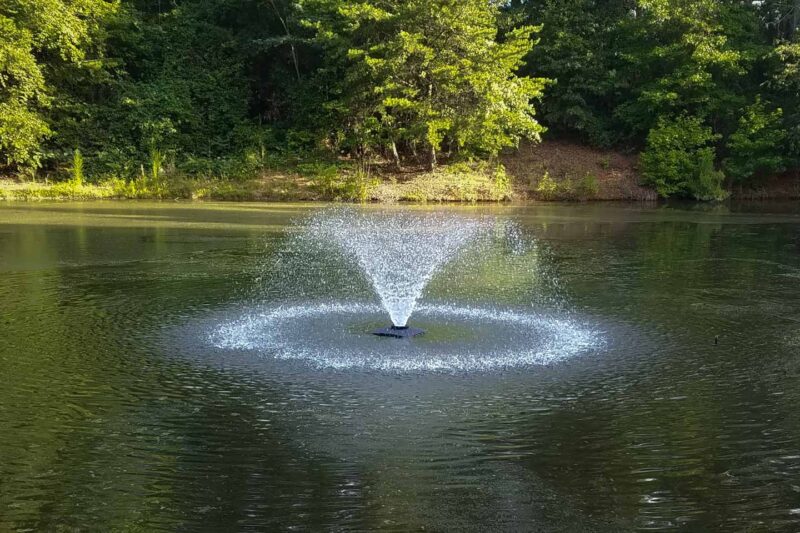
Designed for larger ponds and lakes, these aerators produce strong surface movement, helping to circulate large volumes of water effectively.
Key points:
- Best for large-scale bodies of water
- Creates strong water circulation at the surface
- Effective for maintaining oxygen in expansive areas
Sub-Surface Aerators
When paired with fountains, sub-surface aerators push oxygen into deeper water layers.
It ensures oxygen is available throughout the entire water column, benefiting fish and plants at all depths.
Key points:
- Provides oxygen to deeper water layers
- Works best when combined with surface fountains
- Supports balanced oxygen distribution
Solar vs. Electric Fountains
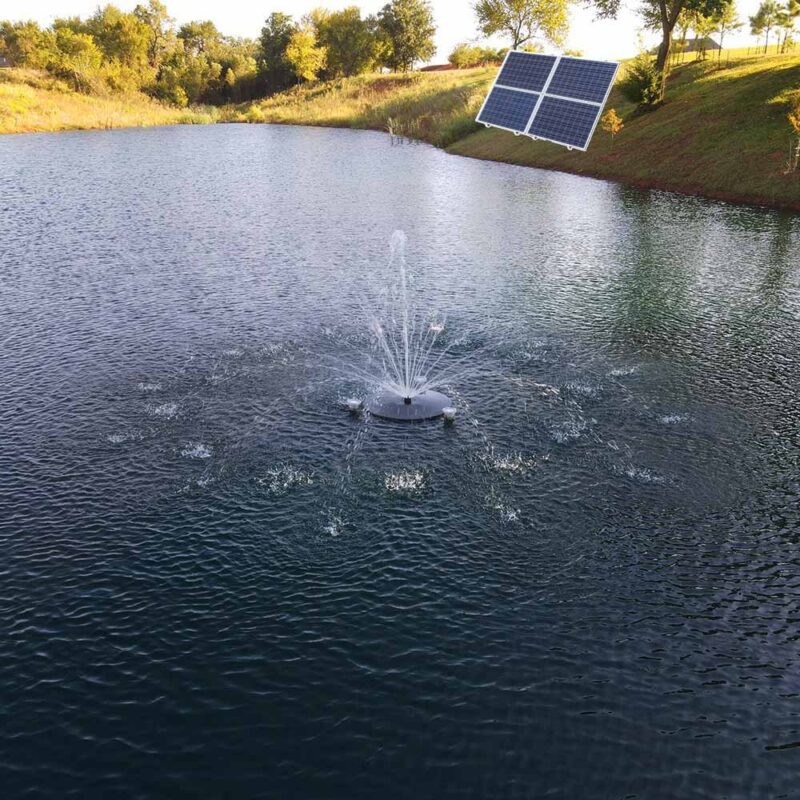
Solar-powered fountains offer energy savings and eco-friendly operation, while electric fountains deliver consistent performance regardless of sunlight.
The choice depends on factors such as budget, location, and desired operating times.
Key points:
- Solar fountains reduces energy costs
- Electric fountains ensure constant operation
- Selection depends on usage goals and resources
-
Solar batteries allow solar fountains to store energy, ensuring they can operate even during cloudy weather or at night
How Fountains Increase Oxygen Levels
Fountains act as natural oxygen boosters in ponds by combining movement, aeration, and mixing.
Every action works together to maintain balanced oxygen levels, support aquatic life, and prevent quality issues.
Their effectiveness can be seen in several key ways, including circulation, surface agitation, spray action, and the prevention of thermal stratification.
The following aspects outline how each process contributes to a healthier pond ecosystem:
Water Circulation
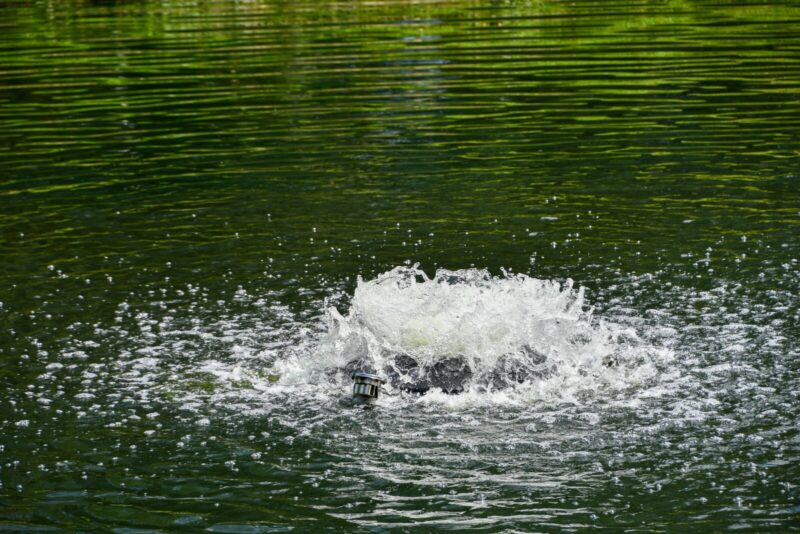
- Continuous water movement prevents stagnation that often leads to foul odors and degraded water quality.
- Even distribution of oxygen and nutrients helps maintain uniform conditions across the pond.
- Reduced risk of low-oxygen “dead zones” ensures fish and other organisms thrive in all areas.
Continuous circulation keeps the ecosystem active, discouraging conditions where harmful bacteria or algae could dominate.
By moving water consistently, fountains help maintain an environment where aquatic species can flourish.
Surface Agitation
- Breaking the surface tension encourages gas exchange between air and water.
- Increases dissolved oxygen while releasing harmful gases like methane and hydrogen sulfide.
- Reduces the buildup of anaerobic conditions that often cause unpleasant odors.
Surface agitation acts as a natural purifier, constantly refreshing the oxygen supply and allowing for healthier interactions between aquatic plants, fish, and microorganisms.
Spray Action
- Droplets capture oxygen as they move through the air before returning to the pond.
- Continuous spraying ensures a constant infusion of oxygen-rich water.
- Supports a stable habitat for fish and beneficial bacteria.
Spray action is visually attractive while functioning as a reliable method of raising oxygen concentrations throughout the day.
It mimics the aeration that naturally occurs in moving streams and waterfalls.
Ecological Benefits of Fountain Aeration
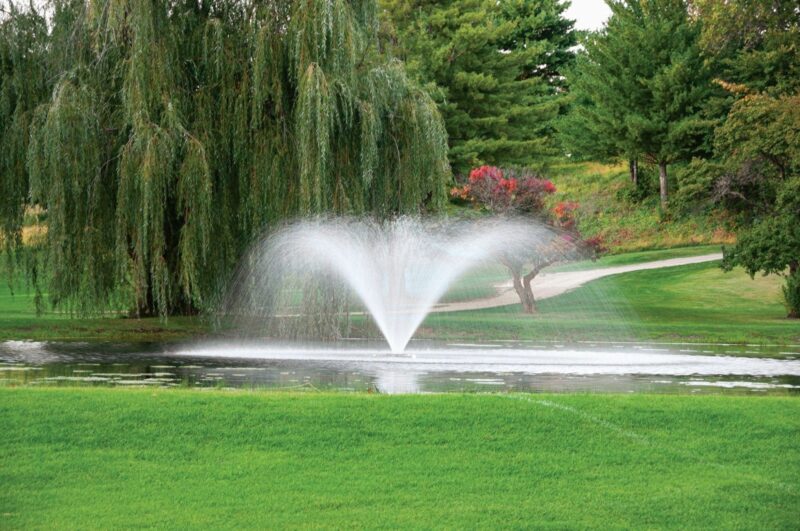
Maintaining healthy oxygen levels in a pond or lake brings multiple ecological benefits that influence:
- Aquatic life
- Plant growth
- Water quality
Fountains not only move water but also create conditions where fish thrive, algae struggle, and mosquito populations remain under control.
Improved Fish Health
Fish require adequate oxygen to survive, and some species are more sensitive to fluctuations in oxygen levels than others.
Continuous aeration ensures they remain healthy throughout seasonal changes.
High summer temperatures can lead to oxygen depletion, while winter ice cover can limit gas exchange, increasing the risk of fish kills.
By keeping oxygen levels consistent, fountains support a stable and thriving fish population.
Key points:
- Supports oxygen-sensitive fish species
- Prevents fish kills in hot summers and under winter ice
- Reduces stress on aquatic life during environmental changes
Enhanced Plant and Bacteria Activity
Beneficial bacteria that break down organic waste depend on oxygen to function effectively.
Increased oxygen levels accelerate decomposition, reducing sludge buildup at the bottom of the pond.
Healthy aquatic plants also benefit, as they can grow steadily without being smothered by decaying material or excess algae.
Key points:
- Boosts activity of beneficial bacteria
- Promotes steady growth of aquatic plants
- Helps maintain nutrient balance in the ecosystem
Algae and Weed Control

Algae thrive in stagnant, nutrient-rich areas.
Fountains disrupt these zones, making it harder for algae and invasive weeds to spread.
By keeping the water in motion and reducing nutrient concentration in one area, fountains naturally suppress unwanted plant growth.
Key points:
- Reduces algae growth by limiting stagnant water
- Controls invasive aquatic weeds
- Helps maintain a balanced ecosystem
Mosquito Reduction
Still water is a perfect breeding ground for mosquitoes.
Moving water generated by a fountain makes it difficult for mosquito larvae to survive, leading to a significant decrease in their population.
It also reduces the risk of mosquito-borne illnesses for humans and animals nearby.
Key points:
- Prevents mosquito breeding in still water
- Decreases mosquito population naturally
- Reduces potential for mosquito-related health risks
Water Quality Improvements

Healthy oxygen levels improve decomposition rates, minimizing the buildup of organic sediment at the pond bottom.
Faster breakdown of waste materials leads to cleaner water, reduced foul odors, and improved clarity.
It creates a healthier environment for aquatic life and a more pleasant setting for people enjoying the area.
Key points:
- Reduces organic sediment accumulation
- Improves clarity
- Minimizes odors caused by anaerobic bacteria
Water Quality Improvements
Healthy water quality depends heavily on consistent oxygen levels.
When oxygen is plentiful, decomposition of organic materials occurs more rapidly such as:
- Fallen leaves
- Fish waste
- Plant debris

It prevents excessive buildup of sediment on the pond floor, which can otherwise lead to nutrient overload and long-term water quality problems.
Clearer water is another result of proper aeration. Increased oxygen levels encourage beneficial bacteria to thrive, which consume organic matter and help filter impurities.
As clarity improves, sunlight penetration increases, promoting balanced plant growth without triggering aggressive algae blooms. Healthy plant life then further contributes to stability by absorbing nutrients that could otherwise fuel unwanted growth.
Foul odors are often linked to anaerobic conditions, situations where oxygen is lacking, and harmful bacteria take over decomposition.
Consistent aeration prevents these anaerobic pockets from forming, resulting in a fresher, cleaner-smelling pond environment.
Such improvements enhance the overall experience for people who visit or live near the water, while also creating a healthier habitat for fish, amphibians, and other aquatic wildlife.
A pond with strong oxygen circulation is both more visually appealing and easier to maintain in the long term.
Summary
Installing a fountain can dramatically improve dissolved oxygen levels while enhancing water movement.
Ecological benefits include healthier fish populations, balanced plant and bacterial activity, and reduced mosquito presence.
Cleaner water, fewer odors, and reduced algae growth add to the functional value.

